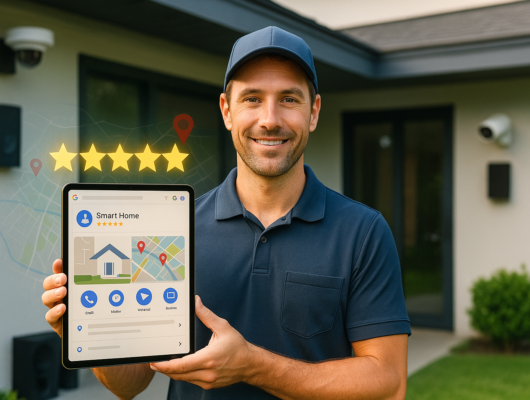The era of the connected home isn’t coming; it’s here. The markets for Audio-Visual (AV), smart home automation, and home security are booming. Projections show the global smart home automation market alone will hit a staggering $254.3 billion by 2034 (CAGR 13.7%).
But this growth brings a challenge: how do you effectively advertise complex, high-consideration products in a noisy digital world? Traditional methods often fall short. Consumers have real concerns about compatibility, security, and ease of use.
This playbook provides a strategic roadmap. We’ll dive into cutting-edge, multi-platform strategies, focusing on the power of Meta Ads (Facebook and Instagram) integrated with a holistic online presence, to connect with today’s smart home buyer. Forget basic clicks; we’re aiming for meaningful engagement and sustainable growth.
1. Decoding the Digital Landscape & the Modern Smart Home Buyer
To effectively advertise smart home tech, you need to understand the evolving digital ad landscape and how your target audience behaves on different platforms. Here are key trends shaping strategy:
Platform Trends Shaping Strategy:
- The Centrality of Artificial Intelligence (AI): AI is no longer optional. Platforms like Google Ads and Meta Ads heavily integrate AI for campaign automation, dynamic creative optimization, audience targeting, and predictive analytics. Leverage AI-powered features like Meta’s Advantage+ campaign budget and Advantage+ audience to optimize your ad spend and reach.
- Social Media as a Discovery Nexus: Platforms like Meta Ads and TikTok are where people discover new products. Younger audiences, in particular, rely on social recommendations. If your target demographic skews younger, consider starting and ending your marketing efforts on these platforms.
- The Privacy Pivot and First-Party Data: Heightened consumer awareness and regulations like GDPR, along with platform changes, have significantly impacted ad tracking and targeting capabilities. This shift necessitates a focus on privacy-centric advertising and elevates the importance of collecting and leveraging first-party data. Tools like Meta’s Conversions API (CAPI) become crucial for maintaining data flow and optimizing campaigns despite browser-side tracking limitations. Building trust through transparent data collection practices is paramount.
- Visual and Video Content Reign Supreme: The digital landscape is increasingly visual. Short-form video content, popularized by platforms like TikTok and Instagram Reels, is highly engaging. High-quality images and compelling video are essential for capturing attention in crowded feeds, particularly on visually oriented platforms like Meta.
Understanding Consumer Behavior Across Platforms:
- Google Ads (The Intent Catcher): People on Google are actively searching for solutions. They type in queries like “best smart thermostat for energy savings” or “home security system installation near me,” demonstrating clear purchase intent. This makes Google Ads exceptionally effective for capturing bottom-of-the-funnel demand, especially for products requiring research or high-ticket items. While the Cost Per Click (CPC) might be higher compared to social platforms, the high intent often translates to better conversion rates for direct response goals. Google’s ecosystem, including Local Services Ads, also offers significant advantages for businesses serving specific geographic areas.
- Meta Ads (The Discovery Engine): On Facebook and Instagram, users are typically in a different mindset – connecting with friends, browsing content, and open to discovering new things. This makes Meta platforms ideal for building brand awareness, generating interest and desire (top and middle-of-the-funnel activities), showcasing the lifestyle benefits and aesthetic appeal of smart home products, and running powerful retargeting campaigns. The visually rich environment supports storytelling and demonstrating product value in context. CPCs are often lower than Google Search, and the platform offers deep demographic and interest-based targeting capabilities.
- TikTok (The Engagement Hub): TikTok primarily attracts a younger demographic that values authenticity, entertainment, and trending content. It’s a video-first platform with immense potential for high engagement and viral reach. While traditionally viewed as having lower direct purchase intent, its influence is growing. Advertising requires a constant stream of fresh, native-feeling video creative, and attribution can sometimes be more complex. Features like Spark Ads, which boost organic content, can be particularly effective.
Implications for Smart Home Marketing:
A nuanced, multi-platform approach is essential. Use Google Ads to capture users actively searching. Leverage Meta Ads to build brand recognition, demonstrate the “why” behind smart tech (convenience, security, savings), showcase visually appealing installations, and retarget interested users. Explore TikTok for broader awareness, especially targeting younger demographics.
The lines between platforms are blurring. Meta’s advanced retargeting and Advantage+ campaigns can drive conversions, not just awareness. Google offers awareness-building through its Display Network and YouTube. The smart home buyer’s journey is rarely linear. Integrate data across platforms (Meta Pixel, CAPI, CRM) to create a cohesive experience that guides prospects from awareness to purchase.
2. Unlocking Meta’s Potential: Advanced Strategies for Smart Home Brands
Meta’s platforms offer a powerful toolkit for AV, smart home, and security businesses. Here’s how to leverage them effectively:
Why Meta Matters for AV, Smart Home & Security:
- Unmatched Reach and Audience Diversity: With billions of monthly active users across Facebook and Instagram, Meta provides access to a vast and diverse audience. This scale allows businesses to reach significant numbers of potential customers, including key demographics like homeowners and tech-savvy millennials who are prime candidates for smart home adoption.
- Compelling Visual Storytelling: The visual nature of Facebook and Instagram makes them ideal for showcasing the tangible benefits and aesthetics of smart home products. High-quality images and videos can effectively demonstrate how devices work, how they integrate into a home environment, and the lifestyle improvements they offer (e.g., convenience, security, ambiance). Video content, in particular, drives high engagement on these platforms.
- Precision Targeting Capabilities: Meta offers exceptionally granular targeting options. Advertisers can define audiences based on demographics, interests, behaviors, and connections. Custom Audiences (targeting website visitors, email lists, past purchasers) and Lookalike Audiences enable highly relevant advertising and efficient scaling.
- Fostering Engagement and Trust: Unlike traditional advertising, social media facilitates two-way communication. Businesses can engage directly with potential customers through comments and messages, answer questions, address concerns, and build a community around their brand. This interaction is crucial for establishing the trust necessary for high-consideration purchases like home security or complex automation systems.
Choosing the Right Tools: Effective Meta Ad Formats:
Selecting the appropriate ad format is crucial for achieving specific campaign objectives. Meta offers a diverse range:
| Ad Format | Best For (Goal) | Smart Home/AV/Security Use Case Example | Key Best Practice |
|---|---|---|---|
| Video Ads | Awareness, Engagement, Consideration, Conversion | Demonstrate easy smart lock installation; Customer testimonial for a security system; Lifestyle video of automated lighting scenes. | Mobile-first (vertical/square), <3s hook, ~30s length, subtitles, clear CTA. |
| Carousel Ads | Consideration, Conversion, Showcase Variety | Compare different security camera models; Show steps to set up a smart thermostat; Highlight features of an AV receiver. | Compelling headline/CTA per card, consistent branding, high-quality visuals. |
| Collection Ads | Consideration, Conversion, Product Discovery | Showcase a smart lighting starter kit; Feature a home theater setup. | Engaging hero visual, accurate Facebook Product Catalog, clear CTAs, optimize feed data with design rules and attributes. |
| Lead Form Ads (Instant Forms) | Lead Generation | Offer a free security consultation; Provide a downloadable smart home planning guide. | Clear value exchange, minimize form fields, CRM integration, fast follow-up, use the “Conversion Leads” objective. |
| Interactive Ads (Polls, Quizzes) | Engagement, Lead Qualification, Audience Insights | Quiz: “Which smart home system is right for you?”; Poll: “What’s your biggest home security concern?” | Keep it simple, visually appealing, relevant to user needs. |
| Augmented Reality (AR) Ads | Consideration, Engagement, Conversion | Visualize a security camera on an exterior wall; See how different smart lighting colors look in a room. | Intuitive experience, clear instructions, high-quality 3D models (often created with Spark AR Studio). |
| Stories & Reels Ads | Awareness, Engagement | Quick smart home feature tip; Behind-the-scenes installation; User-generated content style. | Vertical 9:16, immediate hook, fast-paced, use native elements. |
| Instant Experience Ads | Consideration, Brand Storytelling, Product Explore | Interactive tour of a fully automated home; Deep dive into the technology behind a security system. | Mobile-optimized, rich media mix, clear navigation, consistent branding. |
Pinpoint Precision: Advanced Meta Targeting Tactics:
Effective advertising requires reaching the right audience. Meta’s targeting tools allow for remarkable precision:
- Core Targeting (Demographics, Interests, Behaviors): This forms the foundation. Target users based on:
- Demographics: Age, location, income, homeownership status.
- Interests: “Home Improvement,” “Interior Design,” “Smart Home,” “Home Automation,” “Home Security,” “Internet of Things (IoT),” “DIY,” specific tech brands.
- Behaviors: Purchase behaviors, device usage, “Likely to Move”.
- Custom Audiences: These are among the most valuable audiences, allowing you to reconnect with people who already have some relationship with your brand. Create audiences based on:
- Website Visitors: Target all visitors, or segment based on specific pages visited (e.g., product pages), time spent on site, or actions taken. Requires the Meta Pixel.
- Customer Lists: Upload email addresses or phone numbers of existing customers or leads.
- App Activity: Target users who have installed or interacted with your mobile app (if applicable).
- Engagement: Target users who have interacted with your Facebook Page or Instagram profile.
- Lookalike Audiences: A powerful tool for prospecting and scaling campaigns. Meta’s algorithms identify users who share characteristics with your existing “source” Custom Audiences.
- Advantage+ Audience: This represents Meta’s shift towards AI-driven audience discovery. When selected, Meta’s AI uses signals from your Pixel, past conversions, and ad interactions to dynamically find the audience most likely to achieve your campaign objective.
- Special Ad Category (Housing): It’s crucial to be aware of potential restrictions if your advertising relates to housing opportunities. If your ads fall into this category, you must declare it during campaign setup. This limits certain targeting options.
Nurturing the Sale: Mastering Retargeting for High-Consideration Purchases:
Smart home, AV, and security solutions are rarely impulse buys. Customers often undertake extensive research and consideration over weeks or even months. Retargeting on Meta is therefore not just beneficial, it’s essential for staying top-of-mind during this critical period and guiding interested prospects towards conversion.
- The Foundation: Pixel & Conversions API (CAPI): Accurate tracking is non-negotiable. The Meta Pixel (a code snippet on your website) and the Conversions API (a server-side connection) work together to track user actions like page views, product views, add-to-carts, initiated checkouts, and purchases. CAPI is particularly important for capturing data that might be missed by the browser-based Pixel due to ad blockers or privacy settings.
- Strategic Segmentation is Key: A one-size-fits-all retargeting message is inefficient. Segment your audiences based on their behavior and where they are in the purchase funnel to deliver the most relevant message.
- Dynamic Product Ads (DPAs) / Advantage+ Catalog Ads: These are automated ads that dynamically show products from your catalog to users based on their website activity. Extremely effective for retargeting product viewers and cart abandoners with personalized recommendations. Requires uploading and maintaining a product catalog in Meta Business Manager.
- Ad Sequencing and Messaging: Don’t show the same ad repeatedly. Develop a sequence of ads that guides users logically through the consideration process.
- Offer Strategy: Tailor offers to the audience segment and their stage in the funnel.
- Frequency Control: Monitor how often individuals see your retargeting ads. Excessive frequency leads to ad fatigue, annoyance, and wasted spend.
- Strategic Exclusions: Excluding audiences is as important as including them for efficiency. Always exclude recent purchasers from campaigns aimed at acquiring new customers or recovering abandoned carts.
Table 2: Sample Smart Home Retargeting Funnel on Meta
| Funnel Stage | Audience Definition (Example Lookback Window) | Recommended Meta Ad Format(s) | Content / Offer Strategy | Key Exclusion |
|---|---|---|---|---|
| Website Visitor | Visited website (30 days), NOT viewed product | Video Ad, Single Image Ad | Brand awareness, Educational content (e.g., “5 Benefits of Smart Lighting”), Link to blog | Product Viewers, Cart Abandoners, Purchasers |
| Product Viewer | Viewed specific product/category (14 days) | DPA, Carousel Ad, Video Ad | Show viewed/related products, Highlight features/benefits, Testimonials | Cart Abandoners, Purchasers |
| Cart Abandoner | Added to cart (7 days), NOT purchased | DPA, Collection Ad, Image Ad | Show cart items, Address objections, Offer limited-time discount/free shipping/bundle | Purchasers |
| Past Purchaser | Purchased (180 days) | Carousel Ad, Video Ad, Image Ad | Upsell complementary products, Announce new arrivals, Loyalty program info, Request review | (Targeted specifically, not excluded from relevant offers) |
3. Beyond Silos: Building Integrated Multi-Platform Campaigns
Optimal results come from an integrated multi-platform strategy, combining the power of Google and Meta with foundational digital marketing elements.
The Google + Meta Power Play: Combining Intent and Engagement
Google Ads captures high-intent users actively searching for solutions. Meta Ads excels at building awareness and engaging users who are open to discovery. Use them together strategically:
- Initial Awareness (Meta): Use engaging video and image ads on Meta to introduce your brand and the benefits of your smart home solutions to a broad audience (top of funnel).
- Intent Capture (Google): Target users searching for specific products or services with relevant Google Search Ads (bottom of funnel).
- Remarketing (Meta & Google): Retarget users who interacted with your Meta ads or visited your website via Google Display Ads, YouTube retargeting, and Meta retargeting. Tailor your messaging based on their previous interactions.
- Lead Generation (Both): Use Google Lead Form Extensions and Meta Lead Form Ads to capture leads directly on each platform.
- Conversion Tracking (Integrated): Ensure you have robust conversion tracking in place across both platforms (using Google Analytics, Google Ads conversion tracking, Meta Pixel, and CAPI) to understand the full customer journey and attribute conversions accurately.
Amplifying with SEO and Content Marketing:
Your paid advertising efforts are amplified by a strong organic presence:
- SEO (Google Focus): Optimize your website and content for relevant keywords that smart home buyers are searching for on Google. This provides a consistent source of organic traffic to support your paid campaigns.
- Content Marketing (Cross-Platform): Create valuable content (blog posts, guides, videos) that educates potential customers about the benefits and features of smart home technology, addresses common concerns, and positions your brand as an authority. Share this content across your website and social media platforms. Content can fuel your organic reach and provide valuable assets for your paid campaigns (e.g., lead magnets).
The Power of CRM and Marketing Automation:
A Customer Relationship Management (CRM) system and marketing automation tools are crucial for managing leads and nurturing relationships across platforms:
- Centralized Lead Management: Integrate lead data from Google Ads and Meta Lead Forms into your CRM.
- Automated Follow-Up: Use marketing automation to nurture leads with relevant content based on their interactions with your ads and website.
- Personalized Communication: Leverage data from your CRM to personalize your ad messaging and email marketing.
- Attribution Modeling: Utilize CRM data to gain a clearer understanding of which channels are driving the most valuable leads and customers.
Example Integrated Campaign:
- Meta (Awareness): Run video ads showcasing the convenience of your smart lighting system to a broad audience interested in “Home Improvement.”
- Google (Intent): Target users searching for “best smart light bulbs” with Google Search Ads.
- Website (Education): Offer a detailed guide on “Choosing the Right Smart Lighting for Your Home” as a lead magnet on your website.
- Meta (Retargeting): Retarget users who watched your video or visited your lighting product pages with carousel ads showcasing different lighting styles and a special introductory offer.
- Email (Nurturing): Send automated emails to leads who downloaded your guide, providing more information and case studies.
- Google (Remarketing): Retarget website visitors who didn’t convert with display ads highlighting customer testimonials and a clear call to action to request a quote.
4. Measuring Success and Continuous Optimization
No advertising strategy is set in stone. Continuous monitoring, analysis, and optimization are crucial for maximizing your ROI.
Key Metrics to Track:
- Reach and Impressions: How many people are seeing your ads?
- Click-Through Rate (CTR): How often are people clicking on your ads?
- Cost Per Click (CPC): How much are you paying for each click?
- Conversion Rate: What percentage of clicks are turning into desired actions (leads, sales)?
- Cost Per Acquisition (CPA): How much does it cost you to acquire a customer?
- Return on Ad Spend (ROAS): How much revenue are you generating for every dollar spent on ads?
- Lead Quality: Are the leads you’re generating actually qualified prospects? (Track this in your CRM).
Platform-Specific Insights:
- Google Ads: Analyze search terms, quality scores, and conversion paths. Use Google Analytics to understand on-site behavior of users who clicked your ads.
- Meta Ads Manager: Monitor campaign performance, ad set performance, and ad creative performance. Pay attention to relevance score and cost per result. Use Meta Ads reporting to understand the demographic and placement breakdown of your results.
A/B Testing is Your Friend:
Continuously test different elements of your campaigns:
- Ad Creative: Test different headlines, body copy, images, and videos.
- Targeting: Experiment with different audiences and lookalike percentages.
- Ad Formats: Try different ad formats to see which resonates best with your audience.
- Landing Pages: Test different landing page designs and calls to action.
- Offers: Experiment with different discounts, promotions, and lead magnets.
The Feedback Loop:
Regularly review your campaign performance data and make adjustments based on what’s working and what’s not. Don’t be afraid to experiment and iterate. The smart home market is dynamic, and your advertising strategy should be too.
Conclusion: Building Connected Customers for a Smarter Future
The smart home revolution presents a significant opportunity for AV, automation, and security businesses. By embracing a sophisticated, multi-platform advertising strategy that leverages the strengths of platforms like Meta and Google, integrates with your organic efforts, and prioritizes understanding the modern consumer, you can move beyond simply selling products to building connected customers for a smarter future. The key is to be strategic, data-driven, and always focused on providing value and building trust in this increasingly connected world.
Related Articles
Explore more insights on enhancing your digital presence across various locations:








